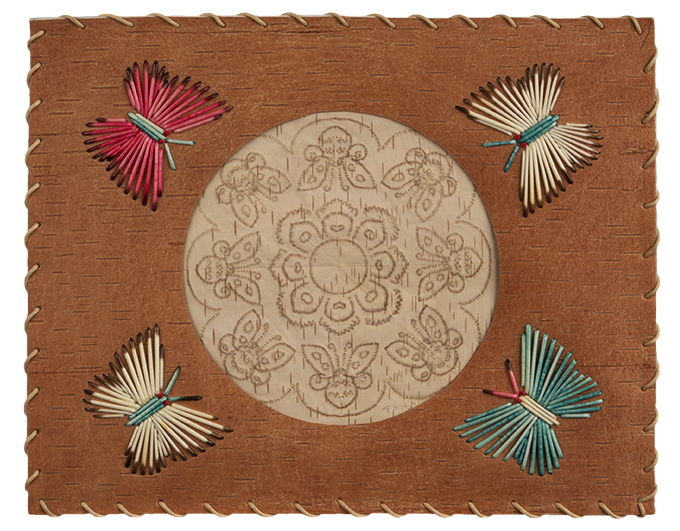
Artist: Angelique Merasty
Title: Butterfly and Flower
Date: circa 1982
Medium: birch bark, porcupine quill, willow root, mat board
Dimensions: 25.5 x 31.5 cm
My pattern is in my mind. I see it all the time I’m working and it comes out perfectly on the birch bark.
— ANGELIQUE MERASTY
Angelique Merasty (1924-1996) produced countless birch bark bitings, and over 40 of those are part of the Gallery’s Permanent Collection. These compositionally complex and intricate works were featured in the 1983 exhibition, entitled Wigwas: Bark Biting by Angelique Merasty.
Born in Amisk Lake, SK, Merasty was a member of the Peter Ballantyne band, a Woodland Cree First Nation in Northeast Saskatchewan. She learned the art from her mother Susan Ballantyne (who also taught Susan Custer) and from watching competitions amongst women in and around her home. Over time, she visualized the entire image before biting into the bark. She developed a distinctly characteristic style that included floral variations, as well as animals, such as insects, hummingbirds, fish, rabbits, owls, ants, beavers, mice, and butterflies. She also applied bitings as decorative elements to the exteriors of bark containers.
Angelique’s husband Bill collected birch bark from the forest around their home in Beaver Lake during the spring season, when it proved easier to peel and supple enough to retain tooth prints. The ideal bark has up to ten layers, and often five or six would prove suitable for biting. Merasty selected thin pieces that suited her vision and then folded each piece numerous times, applying bite marks along the folded lines to make her designs. From time to time, she changed the intensity of the bite to suit the size or detail of the composition.
Pinprick perforations make up the design, and the bark’s textured surface acts as the background. The bark “transparency” was considered complete upon Merasty holding the bark up to the sun so that it warmed to the light and the bite marks became infused with sunshine.
Merasty’s artworks are located in collections around the world, such as the Manitoba Museum, the Smithsonian Institute in Washington, DC, as well as in Britain and Germany. Of her work, Merasty stated, “My pattern is in my mind. I see it all the time I’m working and it comes out perfectly on the birch bark.”
Originally published in The Walleye – MAR 2019
By Andrea Terry, Acting Curator, Thunder Bay Art Gallery

